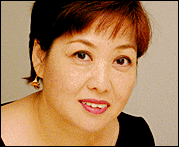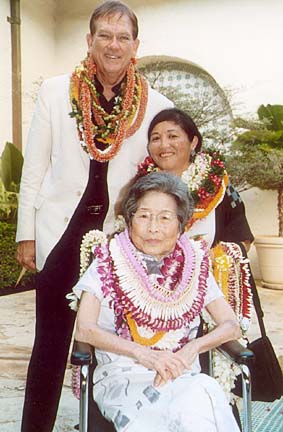


Local Color![]()
Sunday, January 20, 2002

|
Sueko Matsueda Kimura knew very early on that she was different. Finding a nice husband, rearing children and staying on the plantation - all the things that were expected of her - were not in her plans. Recalling a fiery pioneer
Difficult, demanding and fiercely
independent, the late Sueko Kimura
followed her heart to the world of artThe only girl and the fifth of six children born to issei parents in Papa'ikou on the Big Island and reared on Maui, Kimura wanted to be an artist before all else. The first chance she got, she did something about it.
Kimura ran off in a boat for Honolulu after she graduated from high school. Horrified, her parents dispatched her brothers to bring her home. Kimura obeyed but soon made another escape to Honolulu.

|
Her parents relented and allowed her to attend the University of Hawai'i at Manoa where she later received a bachelor's degree in art and met fellow art student and husband-to-be Keichi."To run away like that was unheard of in her days. She was a feminist (but a quiet feminist) before it was the popular thing to do," said Juli Walters, Kimura's daughter.
Kimura was independent and stubborn - but also gracious and elegant even while facing the dissolution of her marriage and bouts with cancer - all her life. She died on Christmas Day. She was 89.
Her survivors, Walters and son-in-law, Riley Jaschke, kept news of her death private until last week. A private service was held.
"My mother was herself to the end. She did things her way; she made sure that in her life, she did what she wanted to do and she pretty much accomplished all her goals," Walters said.
Her mother was resourceful and gutsy, Walters said, recalling when she pulled off a Hawaiian luau for a well-known visiting artist when the family was poor and living in extremely crammed quarters.
"We were living in this really, really tiny house that even I was ashamed of. The front of the house was the garage that my uncles built with scrap lumber. But she wanted to do it, and nothing could stop her," Walters said.
The living room was barely big enough to accommodate the luau table - a door propped up on blocks. With a limited budget, Kimura decorated the place with brown paper and turned the evening into an occasion.
"Mom knew how to do things right. Presentation was very important; things always had to look right and she had a knack for making things look good," Walters said.
Kimura also was demanding and difficult but she always held herself to the same high standards, Walters said.
Kimura was an achiever and a pioneer - establishing herself as a successful artist, traveling the world on her own and becoming one of the first women hired as a full-time faculty member at the University of Hawai'i's art department.
Kimura hadn't planned on having children but she was a caring single mother while her husband served with the distinguished 100th Battalion of the 442nd Infantry Regiment during World War II. She worked as an art director at the Honolulu Star-Bulletin to support her only child and herself.
The couple reunited after the war and moved to New York City for further studies. Upon their return to the islands, her husband was offered a university teaching position, but he felt unsuited and recommended her. She joined the university in 1952 teaching drawing and painting, and retired in 1977.
Both were successful commercial artists for a time, but their marriage soured as their careers took different paths. Kimura's teaching job offered her a steady income and upward mobility while her husband increasingly shunned commercial jobs and focused on his own work.
The couple divorced in 1962. Walters said her parents remained deeply devoted to each other afterward, although they seldom had contact. Neither remarried and Keichi Kimura died in 1988.
Kimura always spoke fondly of the "wonderful letters" she received from her husband during the war, recalled Harue McVay, a university colleague, who remembers her as meticulous and organized.
While they were both recognized Hawaii artists of their time, the Kimuras did not have a joint exhibit until last year. "Inner World, Outer World: The Art of Keichi and Sueko Kimura" in September was a popular exhibit at the Honolulu Academy of Arts.
The Kimuras also were included in another September exhibit at the academy, "Legacy: Facets of Island Modernism," featuring a group of pioneering Hawaii artists. Both exhibits have accompanying catalogues highlighting the artists' lives and work. The catalogues are available through the academy's gift shop.
"The exhibits were the highlights at the end of her life. She was very happy; I think she really like seeing their work hung together in one place," Walters said. Her mother had not been an active artist since the late 1980s because of failing health.
Both of her parents wished to have their ashes scattered at sea. Walters held onto her father's ashes and has temporarily placed her parents' ashes side by side, awaiting the day she will scatter their ashes together at sea.
Gardening Calendar
Suzanne Tswei's art column runs Sundays in Today.
You can write her at the Star-Bulletin,
500 Ala Moana, Suite 7-210, Honolulu, HI, 96813
or email stswei@starbulletin.com